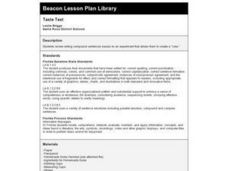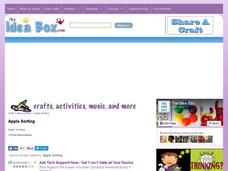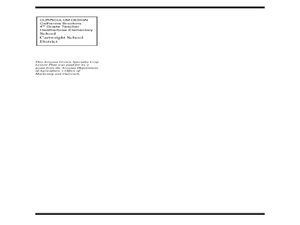Office of Disease Prevention and Health Promotion
Eat Healthy • Be Active Community Workshops
Recipe makeovers, healthy alternatives, quick tips for a nutritious lifestyle...this 187-page document has it all! Don't miss a thorough packet of workshop activities and handouts designed to support your teaching of the MyPlate...
Houghton Mifflin Harcourt
Silly Stories: Challenge Activities (Theme 1)
This packet, the first in the series of support materials for the Houghton Mifflin Harcourt thematic units on silly stories, contains enrichment activities for learners who have mastered the basic concepts of the lessons.
Curated OER
The Magic Apple
A fun and delicious lesson can help your kids learn about plural nouns and story sequencing. After reading The Magic Apple by Rob Cleveland, kids match pictures to story segments and add s to nouns to make them plural. They then cook...
Curated OER
Following a Recipe
Students create a cookbook. In this recipe and writing lesson, students brainstorm the skills necessary to follow a recipe, watch a cooking show and write down a recipe used. Students use a word processing program to write a paragraph...
Curated OER
Sequencing Life Cycles and Daily Activities
First graders sequence story situations. In this sequencing lesson, 1st graders read Charlie the Caterpillar and sequence his life cycle. Students role play the story parts and sing a song about metamorphosis.
Curated OER
A Recipe for Success
Pupils discuss favorite recipes from their home countries and help each other to generate the correct sequencing and grammar for the recipe. They write out the recipe using imperative and passive structures.
Curated OER
Stone Soup
Second graders examine recipes to determine the importance of the sequencing and ingredients. They talk about their favorite family recipes while discussing connections foods brings to families. While reading Stone Soup they focus on the...
Curated OER
Humpty Dumpty Sequencing
Students complete activities for the nursery rhyme 'Humpty Dumpty.' In this nursery rhyme lesson, students recite the rhyme and act it out. Students discuss the rhyme and make up their own. Students bring and discuss hard boiled eggs,...
Curated OER
Making Cranberry Bread
While the preparation for this lesson is extensive, the results are well worth the effort. Prior to the lesson, Xerox the pictures from Cranberry Thanksgiving by Wende and Harry Devlin, collect the ingredients for Cranberry Bread, and...
Curated OER
Folk Tales for ESL Students
Using the folk tale "The Man, The Boy, and The Donkey" (linked in the lesson) and a SMART board, teachers can help pupils access multiple skills. Reading the story allows learners to create a timeline of the sequence of events based on...
Curated OER
Fractions and Recipes
Learners, working with their parents in real world situations, calculate to complete three word problems associated with multiplying and dividing fractions.
Curated OER
Writing Instructions
For this writing instructions worksheet, students rearrange 10 instructions for making tea, so they are in the correct sequence. Students choose a game or activity and write their own instructions to see if a friend can follow them.
Curated OER
Taste Test - Combining Sentences
Students combine sentences to create compound sentences. They write about creating their own soda, then make their own soda, comparing and contrasting it with a national brand. They write a paragraph containing compound sentences.
Curated OER
Cup Cake Recipes
In this reading comprehension worksheet, students read a cupcake recipe and then answer several questions about the recipe. There is also a sequencing sheet to read and follow as well as a parent information sheet to get signed.
Student Handouts
Process Steps
A straightforward graphic organizer is a great way to outline steps for any subject. Kids fill out 10 steps to describe a process or brainstorm writing, with small arrows indicating that one step leads to the next.
Curated OER
Relative Age Dating
Modeling dough and paper cutouts in science class? Learn about how relative age dating concepts, like the Law of Superposition and cross-cutting relationships, can be used to describe the formation of sedimentary layers.
Curated OER
Apple Sorting
Students participate in a recalling activity with three colored felt apples. In this apple lesson, students discuss the colors of apples, sequence apples, and choice a favorite apple. Students participate in an apple tasting.
Curated OER
Fantastic Fraction Fudge
In order to create some tasty fudge, learners must adapt a recipe. Using a recipe for fudge, ingredients must be correctly converted using fractions. If one fraction is incorrect, the fudge will reveal it! Although you will only make one...
Curated OER
"The Drum"
Second graders read and discuss the folktale "The Drum" from India. They also answer story comprehension questions, complete an adjectives and verb worksheet, and label a map of India. Students sequence events from the story and make...
Perkins School for the Blind
Cooking and Kitchen Tools
Independent living skills and skills that can be used to gain employment are very important for any learner. Teens with visual impairments explore the kitchen to understand what everything is and what it all does. The lesson includes a...
Curated OER
In My Life
Third graders sequence an important event that has happened in their life. In this sequencing lesson plan, 3rd graders complete a worksheet that is provided.
Curated OER
Let's Make Stew!
Students investigate how to create a vegetable garden and complete related activities. In this vegetable garden lesson, students receive agriculture notebooks to complete vocabulary for the gardening lesson. Students read 'Still-Life...
Curated OER
Spider "How To" Make a Spider
Young chefs follow the set-by-step instructions of a recipe and use their prior knowledge of the body parts of a spider to make edible spider cookies. After completing a pre-writing graphic organizer they then write a "how to" paragraph...
Curated OER
Cooking With Cuisinaires
Second graders explore fraction with Cuisenaire Rods. In this fraction lesson, 2nd graders recieve "recipe" cards for adding fractions. After practicing, students create their own cards then exchange with each other to check for accuracy.

























